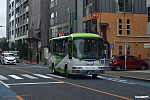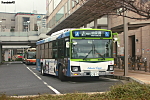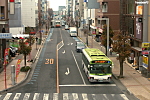Not logged in | Log in | Sign Up

Search Photos
Isuzu BDG-RX6JFBJ Journey J #754
12 september 2018 - Shiki (Saitama Pref.), Honchō 5-chōme (埼玉県志木市本町5丁目), Prefectural Route 244.志04 (shi-04): 柳瀬川駅 (Yanasegawa Station) → 志木駅東口 (Shiki Station East Exit)
Kokusai Kōgyō has a few of these middle-floor shorties for tighter routes. In order to confuse the enemy, they don`t show the route number anyway. This route here is an example of those tighter routes - it runs on streets where deploying a standard-sized bus would block the traffic for the rest of the day. Unfortunately the service level is just abysmal - the number of trips can be counted on Google Street View (12.5 laps Mon-Fri and 9 laps on weekends), and there are approx. three-hour gaps, probably to allow for driver breaks. Overall it connects two subsequent stations on the Tōbu Tōjō line which are only 100 seconds apart by train, but about 15-18 minutes apart on this bus. Overall it`s a curiosity that is probably in the red, but some social level of service must exist - even if it is commercial.


Author: TranslatorPS 

Isuzu QPG-LV290N1 Erga Non-Step #3100
13 december 2018 - Shiki (Pref. Saitama), Honchō 5-chōme (埼玉県志木市本町5丁目), plac terminala autobusowego Shiki-eki Higashi-guchi.志05-3 (shi-05-3): 志木駅東口 (Shiki Station East Exit) → 中宗岡 (Naka-muneoka)
Pod zdjęciem 1064849 pada stwierdzenie, jakoby przewozy po japońskiej aglomeracji stołecznej to była głównie kwestia kolei. Sprostujmy więc lekko temat. Według statystyk podanych przez ministerstwo odpowiednie ds. transportu, w 2010 roku było 385 tys. użytkowników autobusowych biletów okresowych w aglomeracji stołecznej. Oczywiście przy dziennych 40 milionach pasażerów kolejowych oraz 8,5 milionach sprzedanych kolejowych biletów okresowych jest to naprawdę słaba liczba (ledwie niecały 1% użytkowników i prawie 4,5% posiadaczy), ale trzeba wziąć pod uwagę, że odsetek pasażerów korzystających z biletów okresowych w porównaniu do wszystkich jest zaskakująco niski (w 2010 r. w dojeździe do pracy 31% wszystkich pasażerów kontra 60% płacących z e-portmonetek). Kluczowy jest w tym fakt, że wiele dojeżdżających do pracy lub szkoły i jednocześnie korzystających z kolei dystans "ostatniej mili" pokonuje również innymi środkami, jak np. na rowerze (a ile mnie już takich prawie do szpitala zesłało!), czy też na piechotę. W porannym szczycie powszednim pomiędzy 70% a 95% korzystających z autobusów to dojeżdżający do pracy lub szkoły - liczba ta zmienia się zależnie od terminala autobusowego, natomiast ok. 60% wzwyż z tych osób korzysta z autobusów 5 dni w tygodniu, a ogólnie pasażerów regularnych (przynajmniej 2 dni w tygodniu) będzie pomiędzy 80% a 90%. Skalę autobusowych przewozów pasażerskich niech pokaże jednak jeszcze jedna kwestia, którą policzyłem już ja na podstawie informacji na stronach przewoźników. Wybrawszy z niemal setki przewoźników istniejących w aglomeracji tokijskiej kluczowe 18, tylko 14 z nich miało co prawda takową statystykę, ale te 14 firm razem wziętych posiadało na stanie, wliczając również pojazdy dalekobieżne - niespełna 11800 pojazdów. Obrazki więc jak ten wyżej - kilku ładujących pasażerów pojazdów, często wielu firm, są nie dość że uzasadnione, to bezsprzecznie częste... i potrzebne w funkcjonowaniu tego unikatowego organizmu. Brak angielskiego opisu celowy.

Author: TranslatorPS 

Comments: 6
Isuzu PKG-LV234L2 Erga Non-Step #5221
13 december 2018 - Shiki (Saitama Pref.), Honchō 5-chōme (埼玉県志木市本町5丁目), Prefectural Route 244. Now that I mentioned it, Saitama 244 is probably one of the shortest numbered roads in Japan, at only 855 metres.志05 (shi-05): 志木駅東口 (Shiki Station East Exit) → 宗岡 (Muneoka) → 志木駅東口 (Shiki Station East Exit) (circular route)
5221 is finishing its lap on the circular route 志05. The route connects Shiki Station with the low-density residential areas of Muneoka in northern half of the city, close to Arakawa and just short of the border with Saitama city. The route operates as a circular around the core of these residential areas, both clockwise and anti-clockwise. Amusingly enough, for Japan`s love of splitting out variations as separate route numbers, the two directions carry the same route number - it`s only trips cut short that have off-shoots.


Author: TranslatorPS 

Comments: 2
Isuzu PKG-LV234L2 Erga Non-Step #6909
13 december 2018 - Shiki (Saitama Pref.), Honchō 5-chōme, Shiki-eki Higashi-guchi terminus (埼玉県志木市本町5丁目).志05 (shi-05): 志木駅東口 (Shiki Station East Exit) → 宗岡 (Muneoka) → 志木駅東口 (Shiki Station East Exit) (linia okólna)
This is the third photo within a kilometre of each other now, and a third bus company. When it comes to integration, Europe is like a heaven. It`s impossible to see ticket unions here (with minor exceptions regarding day tickets, like in Kyōto). On-stop passenger information usually leads to a forest of stops, as each operator places their own flags and schedules, although oddly enough termini are well integrated. As for the Internet, most companes refer over to nation-wide search engines, such as Navitime, but even then often to separate subpages that only cover their own services. Most trips are paid on a trip by trip basis, and because of long-term tickets - commuter passes as they`re referred to here - it`s impossible to find network-wide tickets spanning over multiple operators. There are, however, routes operated by two operators simultaneously, surprisingly enough, and in those cases one can actually buy a commuter pass covering both operators on that route. The cherry on top of the icing lays in the network maps on board the buses which show... only the routes operated by that particular garage.


Author: TranslatorPS 

Comments: 1



